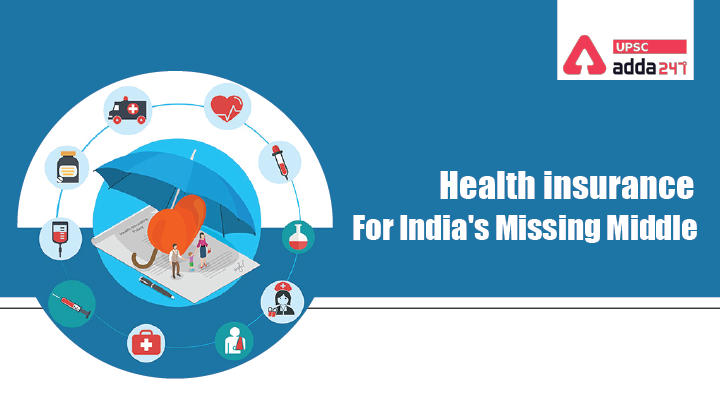Table of Contents
Health Insurance for India’s Missing Middle: Relevance
- GS 2: Issues relating to development and management of Social Sector/Services relating to Health, Education, Human Resources.
Have you cleared UPSC CSE Prelims 2021? Register Here for Free Study Material
Health Insurance for India’s Missing Middle: Context
- NITI Aayog has recently released a report titled, ‘Health Insurance for India’s Missing Middle’ where it has reported that 40 crore ‘missing middle’ has no financial protection for health.
‘Missing middle’ meaning
- The ‘missing middle’ is a broad category which lacks health insurance, positioned between the deprived poorer sections, and the relatively well-off organized sector.
- The deprived and poor sections receive Government subsidized health insurance, while the relatively well-off in the organized sector of the economy are covered under social health insurance, or private voluntary insurance.
- The missing middle refers to the non-poor segments of the population who remain prone to catastrophic, and even impoverishing health expenditure, despite the financial capacity to pay for contributory health insurance.
- The missing middle constitutes the self-employed (agriculture and non-agriculture) in rural areas, and a broad array of occupations – informal, semi-formal, and formal – in urban areas.
NITI Aayog’s Geospatial Energy Map of India
Health Insurance for India’s Missing Middle: Key findings
- Low Government expenditure on health has constrained the capacity and quality of healthcare services in the public sector.
- At least 30% of the population, or 40 crore individuals – called the missing middle in this report – are devoid of any financial protection for health.
- In the absence of a low-cost health insurance product, the missing middle remains uncovered despite the ability to pay nominal premiums.
NITI AAYOG Handbook on Sustainable Plastic Management
Challenges in increasing insurance penetration
- Awareness: Consumer education of health insurance, especially amongst the missing middle, is important to increase its uptake.
- Identification: Targeting the missing middle segment will require a different outreach strategy which distinctly focuses on this population.
- Affordability: The missing middle population is highly price sensitive. Lowering the costs of the product, where feasible, will be important to ensure affordable prices and high demand.
Not-for-Profit Hospital Model Study: NITI Aayog
Health Insurance for India’s Missing Middle: Recommendations
- The report has recommended three models for increasing the health insurance coverage in the country.
- The first model focuses on increasing consumer awareness of health insurance,
- The second model is about “developing a modified, standardized health insurance product” like ‘Arogya Sanjeevani’, a standardised health insurance product launched by the Insurance Regulatory Development Authority of India (IRDAI) in April 2020.
- A “slightly modified version” of the standardised Aarogya Sanjeevani insurance product will help increase the update amongst the missing middle.
- The third model expands government subsidized health insurance through the PMJAY scheme to a wider set of beneficiaries.
- This model can be utilized for segments of the missing middle which remain uncovered, due to limited ability to pay for the voluntary contributory models outlined above.
- This is the only model out of three proposed which has fiscal implications for the Government.
- Though this model assures coverage of the poorer segments on the missing middle population, premature expansion of PMJAY can overburden the scheme




 TSPSC Group 1 Question Paper 2024, Downl...
TSPSC Group 1 Question Paper 2024, Downl...
 TSPSC Group 1 Answer key 2024 Out, Downl...
TSPSC Group 1 Answer key 2024 Out, Downl...
 UPSC Prelims 2024 Question Paper, Downlo...
UPSC Prelims 2024 Question Paper, Downlo...




